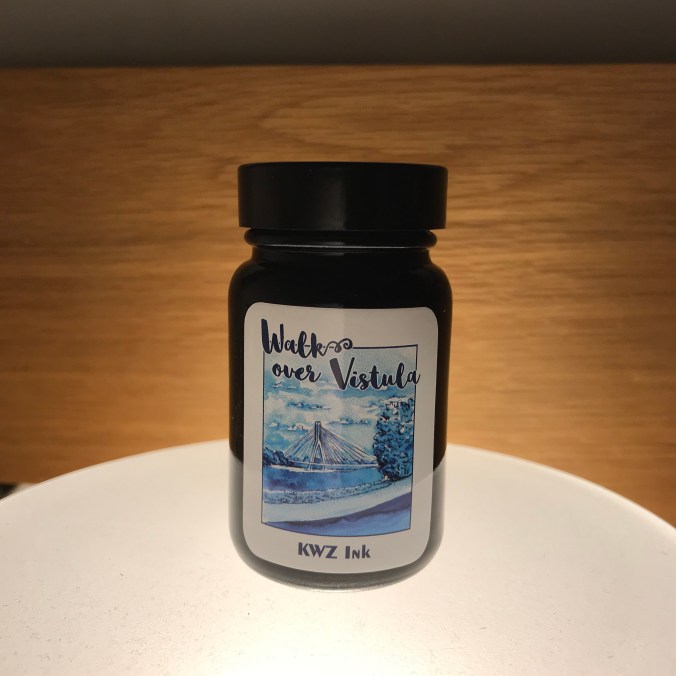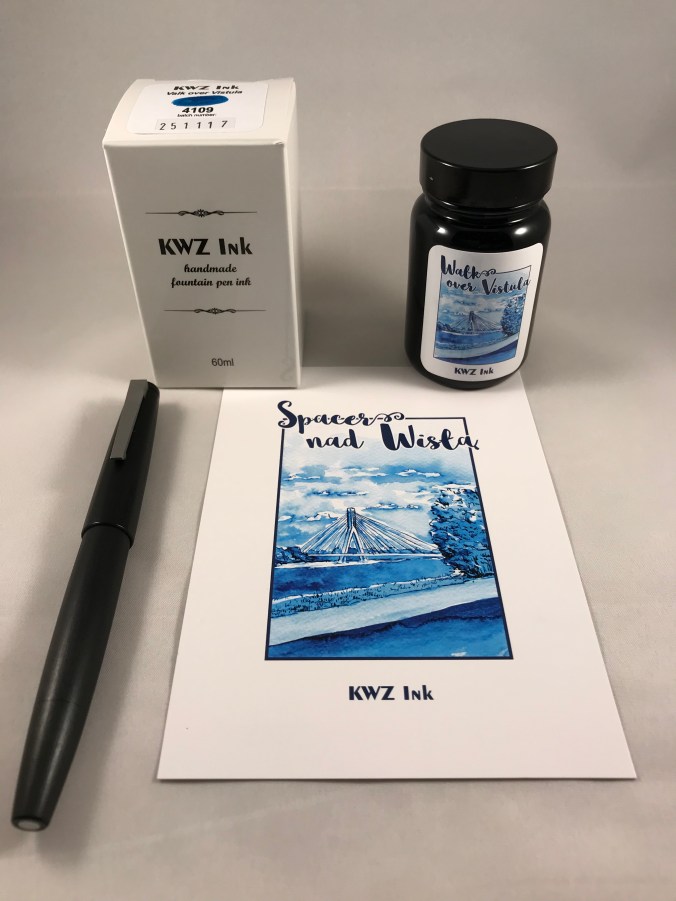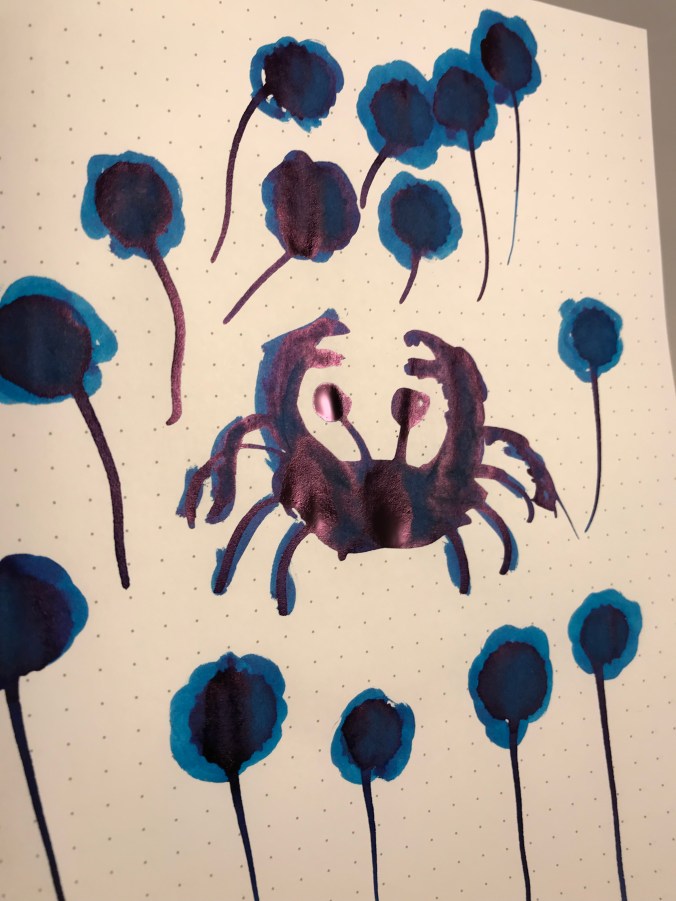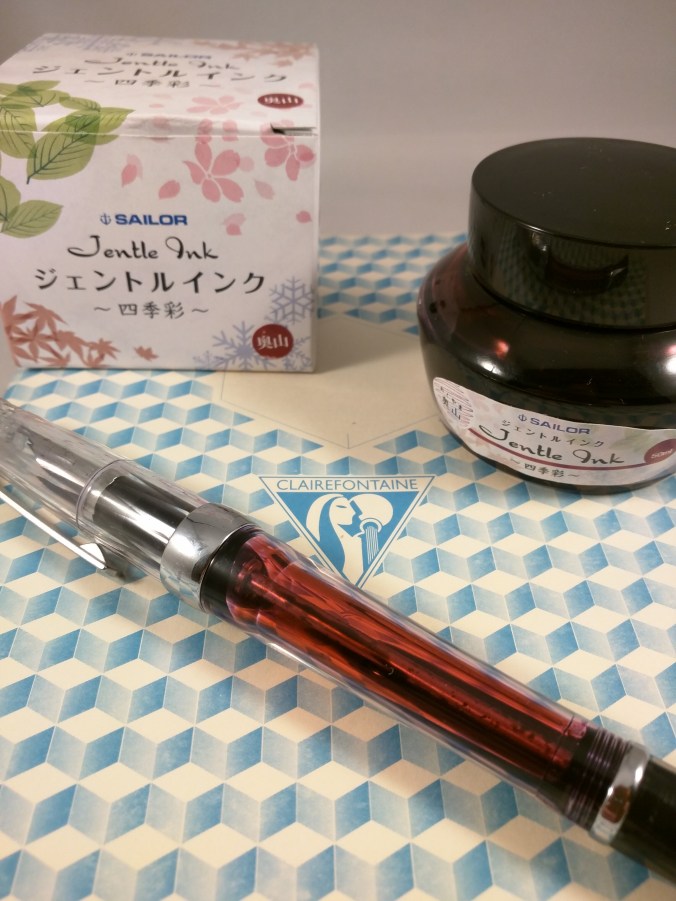The back story of KWZ inks is pretty well known. They’re made in Poland by a husband and wife team and include a range of iron gall inks alongside their “normal” inks. In late 2017, to mark Polish Independence Day, KWZ added three suitably-themed inks to their standard line-up. I bought all three earlier this year, but have so far mainly used Walk Over Vistula.

In search of enlightenment

Ink drops seemed a bit dull, but I have no idea what prompted this combination as an alternative
A brief internet search tells me that the Vistula is Poland’s longest river which flows through Krakow and Warsaw. I have no idea what colour the waters of the Vistula are, but Walk Over Vistula is a turquoise-blue ink. I’m reluctant to call it teal, because I don’t think it has enough green in it. This is quite a crowded field with plenty of competition to be found (see swatches later). As it turns out, it’s also a colour I like. Of the 11 inks I swabbed for comparison, I own full-sized bottles of 7 of them!
For some reason, the camera on my iPad had some issues with colour accuracy resulting in the ink looking like it is more blue than turquoise. I tried persuading it of the error of its ways, but it wasn’t having any of it. You’ll have to take my word for it about the true nature of the colour. Sorry about that.
The ink comes packaged in the same way as other KWZ inks. You get 60ml of ink in a glass bottle, shipped in a fetchingly minimal box. Handily, the top of the box has a small colour swatch on it. If you store your inks inks in a box like me, it makes it easy to pick out the ink you want. The bonus with the “independence” inks is that you get a postcard that showcases the ink colour.

So what’s it like?
Likes and dislikes about ink are very subjective, but I’m definitely in the “like” camp for Walk Over Vistula. Aside from the rich colour, you get an ink that is pretty well saturated and which flows well. In my fine-nibbled Lamy 2000, this equated to a wet line with not a lot of shading. For comparison I also inked up a Lamy Safari with a stub nib. As well as getting the benefit of a wider line, the relatively stingy ink flow is a good way of holding back more “enthusiastic” inks, helping to show off colour and shading.


Both samples were written in a Taroko Breeze notebook which features white 68gsm Tomoe River.
What the writing samples don’t show is the sheen that comes with this ink. As someone who enjoys a bit of sheen, I was very slow on the uptake in spotting the sheen on this ink. You can’t avoid it on Tomoe River paper. I haven’t tried any Rhodia, but the sheen was also evident on the paper in my TWSBI notebook.

Something tells me that drawing crustaceans is not my strong point
In terms of looky-likeys, one of my first thoughts was Pilot Iroshizuku Ku-jaku. Looking at the swatches, maybe Blackstone Barrier Reef Blue and various of the Robert Oster inks are nearer to the mark. I think my reluctance to badge this as a teal ink is borne out by comparison with Sailor Jentle Yama dori.

Note to self, make sure the page is flat to avoid fuzzy bits
A bit of kitchen chromatography doesn’t reveal any great surprises

I haven’t tested Walk Over Vistula for waterproof-ness, but I’m pretty confident it’s not. This isn’t a deal-breaker for me as I don’t tend to need waterproof inks. Similarly, it’s not the quickest drying, but not outrageously slow either.
Despite there being a number of similar alternatives to this colour, I’m enjoying using it. Two pens in my current rotation are inked with it. I’m more than happy to recommend this ink in its own right, but when you take into account the fact that you get 60ml at the price of KWZ’s standard ink range.
I got my bottle from Bureau Direct for £12.95, but you can also get it from The Hamilton Pen Company. In the US, you can get Walk Over Vistula from Vanness.
Enjoy.







